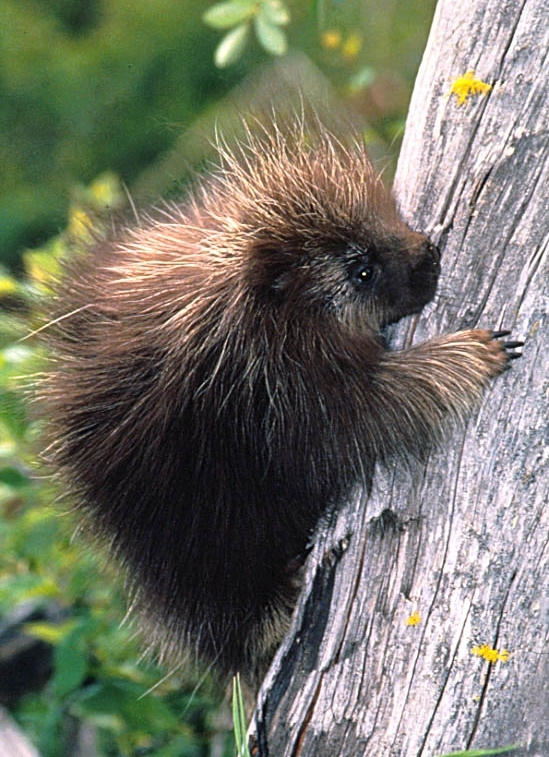

(rodents)
With over 2000 living species placed in about 30 families, rodents are by far the largest order of mammals, at least in terms of number of taxa (well over 40% of mammalian species belong to the order Rodentia!). Rodents range in size from pygmy mice weighing 5 gms to capybaras, the largest of which weigh over 70 kg. They are found around the world except in Antarctica, New Zealand, and on some oceanic islands. Ecologically, they are incredibly diverse. Some species spend their entire lives above the ground in the canopy of rainforests; others seldom emerge from beneath the ground. Some species are highly aquatic, while others are equally specialized for life in deserts. Many are to some degree omnivorous; others are highly specialized, eating, for example, only a few species of invertebrates or fungi.
Despite their morphological and ecological diversity, all rodents share one characteristic: their dentition is highly specialized for gnawing. All rodents have a single pair of upper and a single pair of lower incisors, followed by a gap (diastema), followed by one or more molars or premolars. No rodent has more than one incisor in each quadrant, and no rodent has canines. Rodent incisors are rootless, growing continuously. Their anterior and lateral surfaces are covered with enamel, but their posterior surface is not. During gnawing, as the incisors grind against each other, they wear away the softer dentine, leaving the enamel edge as the blade of a chisel. This "self sharpening" system is very effective and is one of the keys to the enormous success of rodents.
The condition of a dominant pair of incisors used for gnawing, followed by a long diastema, is not unique to rodents, and in fact rodents are relative latecomers to this condition (even though as a group, they have a very old fossil history, going back to Paleocene times). It is even seen in a group of therapsids (ancestors of mammals), the tritylodonts, which lived during the Jurassic. Multituberculates, a very large and successful but now extinct group of early mammals, had a similar pattern. So do wombats, hyraxes, aye-ayes, and lagomorphs, to give a few examples chosen from modern mammals. Rodents have specialized in gnawing to an extreme, however, seen in few or no other groups of vertebrates.
The main muscle used in chewing by rodents is the masseter, and the rodents can be divided into several groups based on exactly how they use these muscles. These groupings have been used in several ways in the past to classify rodents.
Other characteristics of rodents include a well-developed pterygoid region of the skull (the pterygoid muscles, which originate in this region, participate in the movement of the lower jaw), an elongate glenoid fossa with no postglenoid process (permitting the lower jaw to move forwards and backwards), complete zygomatic arch with the midportion spanned by the jugal, large paroccipital processes, alisphenoid canal present (but sometimes short and hard to see), and region between the orbits sometimes constricted and sometimes with postorbital processes. Other characteristics include clavicles usually present, the feet primitively 5-toed (the pollex often very small), digits 2-5 with claws, pollex and hallux sometimes with a nail, reduced temporalis muscle, and many others.
Here, we follow Carleton (1984) in recognizing two suborders, the Sciurognathi and Hystricognathi. The myomorph and sciuromorph taxa are included in the Sciurognathi, while most hystricomorphs are in the Hystricognathi.
Families of Order Rodentia Suborder Sciurognathi Family Aplodontidae (mountain beaver, sewellel) Family sciuridae (squirrels) Family Castoridae (beavers) Family Geomyidae (pocket gophers) Family Heteromyidae (kangaroo rats, pocket mice, and allies) Family Dipodidae (birch mice, jumping mice, jerboas) Family Muridae (familiar rates and other rodents) Family Anomaluridae (scaly-tailed squirrels) Family Pedetidae (spring hare, springhaas) Family Ctenodactylidae (gundis) Family Myoxidae (dormice and hazel mice) Suborder Hystricognathi Family Bathyergidae (mole rats, blesmols, and rats) Family Hystricidae (Old World porcupines) Family Petromuridae (rock rat or dassie rat) Family Thryonomyidae (cane rats or grasscutters) Family Erethizontidae (New World porcupines) Family Chinchillidae (Chinchillas and viscachas) Family Dinomyidae (pacarana, branick rats, false paca) Family Caviidae (cavies and guinea pigs) Family Hydrochaeridae (capybara) Family Dasyproctidae (agoutis, acouchis) Family Agoutidae (pacas) Family Ctenomyidae (tuco-tucos) Family Octodontidae (degus, coruros, rock rats) Family Abrocomidae (chinchilla rats, chinchillones) Family Echimyidae (spiny rats) Family Capromyidae (hutias, zagouties, cavies, Indian coneys) Family Heptaxodontidae (Quemi, giant hutias) Family Myocastoridae (nutria, coypu)<<<<<<<>>>>>>> ARTIODACTYLA CARNIVORA CETACEA CHIROPTERA DASYUROMORPHIA DERMOPTERA DIDELPHIMORPHI DIPROTODONTIA HYRACOIDEA INSECTIVORA LAGOMORPHA MACROSCELIDEA MICROBIOTHERIA MONOTREMATA NOTORYCTEMORPHIA PAUCITUBERCULATA PERAMELEMORPHIA PERISSODACTYLA PHOLIDOTA PRIMATES PROBOSCIDEA RODENTIA SCANDENTIA SIRENIA TUBULIDENTATA XENARTHRA
Email: eradani7@aol.com